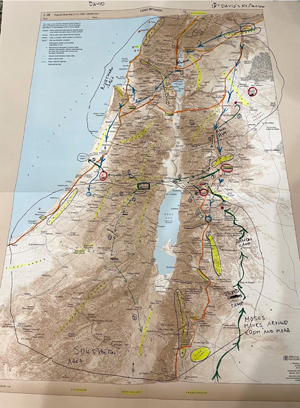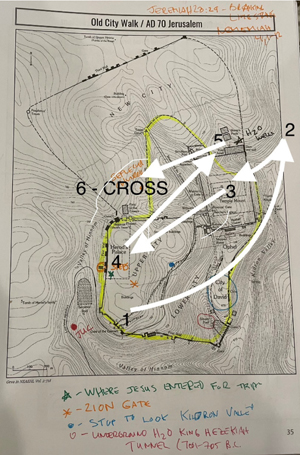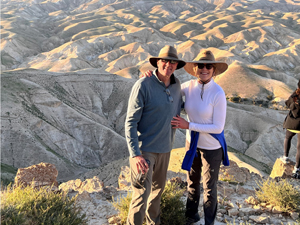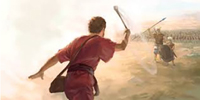
Q: How to celebrate your wife’s 60th birthday?
A: Take her to Israel for two weeks of long, hot, dirty, life-changing hikes all over the Promised Land!
Nancy and I went together to Israel during our first term in Congress in 2009. Since we were part of a group from Congress, our trip was heavy with official events: meet with Prime Minister Benjamin Netanyahu, President Shimon Peres and Palestine President Mahmoud Abbas; tour the “school bus bomb shelter capital of the world,” Sderot, in the Gaza Strip; hear gunfire on the Golan Heights; and float in the Dead Sea. Nancy went back to Israel a few years later to focus on Jesus’ life with Mary Willis and Merry Ministries. Nancy and I were planning to go back in 2020 with our church pastor, Chappell Temple. The COVID pandemic hit in February 2020 – trip cancelled. COVID cancelled our 2021 and 2022 plans. COVID waned heading to 2023, and we were finally going back to Israel! We arrived in Israel on Nancy’s birthday, March 5th, 2023.
Our 2023 trip to Israel was unique. It was not a guided tour in an air-conditioned luxury bus. We enrolled in a two-week college class at Jerusalem University College. Our instructor was Dr. Jack Beck. Dr. Beck is an ordained minister with a doctoral degree. His expertise is teaching the Bible and Jesus Christ’s life through the geography of Israel. If you understand where the drinking water is, where the good lands for farming are, where the trade paths for the world are, where lands that can or cannot be defended are, you will get an insight as to how Jesus chose the specific locations for his ministry. And we would walk everywhere, because that’s how Jesus got from point to point. My appreciation for the words of the Bible and Christ’s sacrifice became clearer and more powerful when combined with the geography of Israel.
 Weeks before we left for Israel, we had to mark up seven maps of Israel with specific colors for trade routes, routes of retreats, routes of pursuit, battles and cities of importance. Map 1 was the easiest – big picture – from the Mediterranean Sea to the Persian Gulf. Each successive map was more detailed. Map 2 focused on Israel. Map 3 was the North and Central areas of Israel. The Lower Galilee and the fertile Jezreel Valley were Map 4. The Southern Trade Routes were addressed in Map 5. Judah was Map 6. Our last map, Map 7, was the land of Benjamin.
Weeks before we left for Israel, we had to mark up seven maps of Israel with specific colors for trade routes, routes of retreats, routes of pursuit, battles and cities of importance. Map 1 was the easiest – big picture – from the Mediterranean Sea to the Persian Gulf. Each successive map was more detailed. Map 2 focused on Israel. Map 3 was the North and Central areas of Israel. The Lower Galilee and the fertile Jezreel Valley were Map 4. The Southern Trade Routes were addressed in Map 5. Judah was Map 6. Our last map, Map 7, was the land of Benjamin.
Our days were long: breakfast by 6:30 am, hiking to study the land and the Bible, dinner around 7 pm, and then to bed. We had only one day off. We hiked on mountains, plains, barren land and lush forests. We walked through streams and slipped in the mud during rains. Our journey was Fort Bend Strong.
I have tons of stories about our two weeks in Israel. Since I am writing a column and not a tome, I’ll share three of my best memories. My first memory came from our first two days walking around Jerusalem. We went inside and outside the historic wall. The Jewish Quarter, the Muslim Quarter, the Christian Quarter, the Armenian Quarter, the Temple Mount, the City of David, the Dome of the Rock, the Room of the Last Supper, the Church of the Holy Sepulchre, the Western Wall, the Mount of Olives and the Garden of Gethsemane – we walked to all of these sites.
I did not fully appreciate Christ’s sacrifice for us until I walked the steps he walked to be crucified. Jesus and his disciples ate the Last Supper inside the Wall near our university. After finishing their meal, they walked east, outside of the wall and through the steep Kidron Valley to rest in the Garden of Gethsemane. Jesus had just walked past the Temple Mount, where the Jewish leaders were preparing a charge of blasphemy with a punishment of death. Sometime during the evening, Jesus sees the torches of the accusers coming to arrest him. He wakes his Disciples so they could greet the accusers. His captors march Jesus back across the Kidron Valley to the Temple Mount. The Jewish religious leaders, Sanhedrin and Caiaphas, find Jesus guilty of blasphemy and sentence him to death.

Jesus’ walking journey to crucifixion.
1. Last Supper with disciples.
2. Garden of Gethesmane.
3. Temple Mount (Jews charge blasphemy).
4. Herod’s Palace (Pontius Pilot charges treason).
5. Roman Army Barracks (Tortured, prepared for Cross).
6. Church of the Holy Sepulcre (Site of crucifixion).
Just before sunrise, Jesus’ conviction is changed to treason against Rome. He now has to walk across Jerusalem to Herod’s Palace where Pontius Pilot is waiting. Jesus is sentenced to die by crucifixion and walked back across Jerusalem to a small Roman army barracks in the east side of the city. The Romans rip off his clothes and severely beat him. It’s about 7 am. The Roman guards make Jesus drag his own cross, uphill, to the Church of the Holy Sepulchre. The crucifixion of Jesus Christ starts around 9 am. The last breath Jesus took was sometime after 3 pm.
From dinner to arrest to conviction was possibly SEVENTEEN hours of nearly constant walking and abuse. I knew the depths of the sacrifice and love Jesus had for us, but I didn’t fully comprehend it until I walked the same steps He walked before He died.
My second memory is the Temptation of Christ. Matthew 4:1-11, Luke 4:1-13 and Mark 1:12-13 describe the Temptation. Jesus knew that he was going to die on the cross to absolve us of all sin. He knew the Devil and the forces of evil were going to make his mortal death very painful. He needed to face the Devil’s temptation to test the limits of his humanness. He could not falter. He must be alone like he would be on the cross. Our Lord must feel extreme thirst, hunger, dehydration, hallucinations, cold, heat and pain. He must face the Devil in the harshest part of Israel – the wilderness.
Israel’s wilderness is not a dense forest of trees, plants and animals like many Americans envision when they hear the word “wilderness.” The wilderness of Israel is barren, low mountains on the west side of the Dead Sea. Nothing grows there. It is very close to Jericho – less than a single day of walking away. Luke 18:35 – 19:28 describes Jesus healing a blind beggar in Jericho shortly before his crucifixion. Knowing what Jesus knew about his fate and his need to confront the Devil before his death, historians believe Jesus walked from Jericho to meet the Devil in the Judean wilderness. Dr. Beck led our group on a 15-minute hike near Hyrcania to see the area where Christ was likely tempted by the Devil for forty days. I saw one bird flying over the valley. I did not see any sign of live animals on the ground. There was no vegetation except for small scrub brush in the middle of rocks. There was no sign of water – just rock after rock after rock.

Pete and Nancy in Israel’s barren wilderness.
Based on my U.S. Navy survival training in the California deserts, a normal man would start hallucinating after three days without water. The ability to reason becomes very impaired. The human body shuts down and dies after one week in these conditions. Jesus defeated the Devil in the wilderness – he was now prepared to defeat the Devil and sin on the cross. It was easy for Nancy and me to smile and rejoice in our faith standing over the wilderness because of the temptation Jesus Christ faced there and defeated for us.
My final memory is one most of us know from our youth – a young shepherd, David, going to battle with a massive man, Goliath. Dr. Beck explained that the battle was more than a young boy trying to prove he was a man and a leader.
God choose the Elah Valley as the place to start David on his path to be the chosen king. The pagan Philistines controlled of the cities of Ekron and Gath. The global trade routes from these two cities converged in Azekah, the entry point to the fertile Elah Valley with trade routes to Gaza, Galilee, Bethlehem and Jerusalem. The Philistines wanted Jerusalem. They moved through Azeka and set up camp in the Elah Valley, west of Socoh. King Saul set up camp east of Socoh. Saul was a timid leader and refused to engage Goliath or the Philistines. Goliath came to the battle line and dared the Israelis to come out and fight. Saul refused to fight, so David answered the call to confront Goliath armed only with the sling David used to protect his flock of sheep from attack.

The quintessential batle: David vs. Goliath
Dr. Beck showed us where the battle likely occurred, and told us Goliath never had a chance, because the Lord and superior geography were behind David. Goliath’s main weapon was a huge spear that he could heave about 40 yards. On the other hand, David, with his sling, could fire a small rock for nearly 100 yards, traveling more than 100 miles per hour with devasting accuracy. Dave killed Goliath with his first stone and then cut off Goliath’s head. The Philistines fled in utter terror, knowing that Israel had just found a new leader. Learning this story made my think of Texas, where defeating a vastly superior opponent is a regular. Underdogs are Fort Bend Strong.
I’m rapidly approaching 10,000 words. I could go on for another 1,000,000 words about my Bible through geography experience in Israel – the first Jewish temple with the Ark of the Covenant at Shilo, Nathanael asking, “Can anything good be from Nazareth (where Jesus lived most of his life), the towering Masada Fortress over the Dead Sea, being re-baptized with Nancy in the Sea of Galilee – the same water John used to baptize Jesus, etc. Nancy and I were able to LEGALLY bring a 3,000 year-old piece of pottery home, because Israel law does not consider objects sitting above the ground to be historic.
I’m always looking for Fort Bend Strong stories – pete@absolutelyfocusmedia.com. Yours always, in Fort Bend Strong!